Architecture of ksqlDB for Confluent Platform
You can use ksqlDB to build event streaming applications from Apache Kafka® topics by using only SQL statements and queries. ksqlDB is built on Kafka Streams, so a ksqlDB application communicates with a Kafka cluster like any other Kafka Streams application.
ksqlDB Components
ksqlDB has these main components:
ksqlDB engine – processes SQL statements and queries
REST interface – enables client access to the engine
ksqlDB CLI – console that provides a command-line interface (CLI) to the engine
ksqlDB UI – enables developing ksqlDB applications in Confluent Control Center (Legacy) and Confluent Cloud
ksqlDB Server comprises the ksqlDB engine and the REST API. ksqlDB Server instances communicate with a Kafka cluster, and you can add more of them as necessary without restarting your applications.
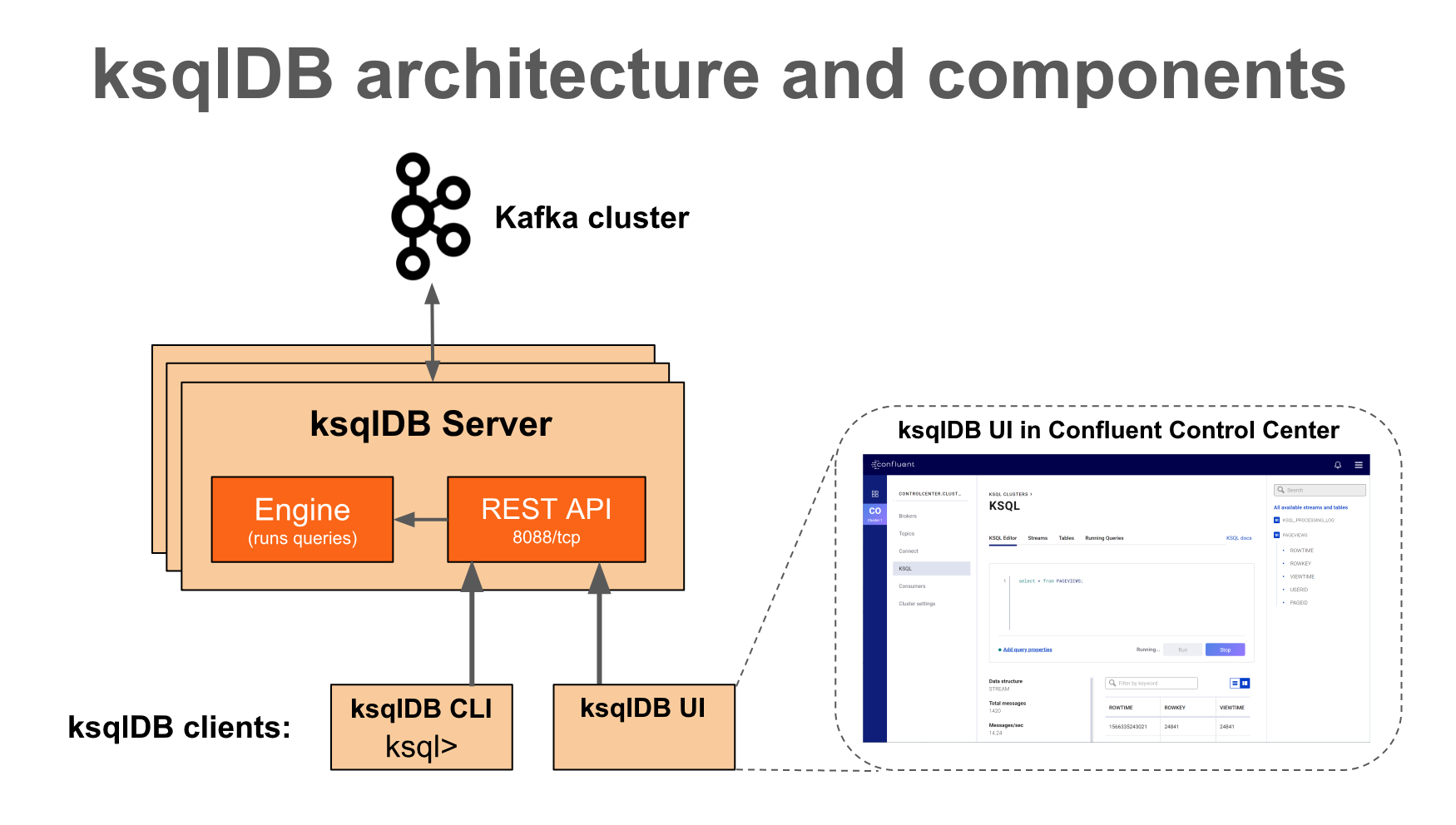
Diagram showing architecture of ksqlDB
ksqlDB Engine: The ksqlDB engine executes SQL statements and queries. You define your application logic by writing SQL statements, and the engine builds and runs the application on available ksqlDB servers. Each ksqlDB Server instance runs a ksqlDB engine. Under the hood, the engine parses your SQL statements and builds corresponding Kafka Streams topologies. The ksqlDB engine is implemented in the KsqlEngine.java class.
ksqlDB CLI: The ksqlDB CLI provides a console with a command-line interface for the ksqlDB engine. Use the ksqlDB CLI to interact with ksqlDB Server instances and develop your streaming applications. The ksqlDB CLI is designed to be familiar to users of MySQL, Postgres, and similar applications. The ksqlDB CLI is implemented in the io.confluent.ksql.cli package.
REST Interface: The REST server interface enables communicating with the ksqlDB engine from the CLI, Confluent Control Center (Legacy), or from any other REST client. For more information, see ksqlDB REST API Reference. The ksqlDB REST server is implemented in the KsqlRestApplication.java class.
When you deploy your ksqlDB application, it runs on ksqlDB Server instances that are independent of one another, are fault-tolerant, and can be scaled with load. For more information, see ksqlDB Deployment Modes.
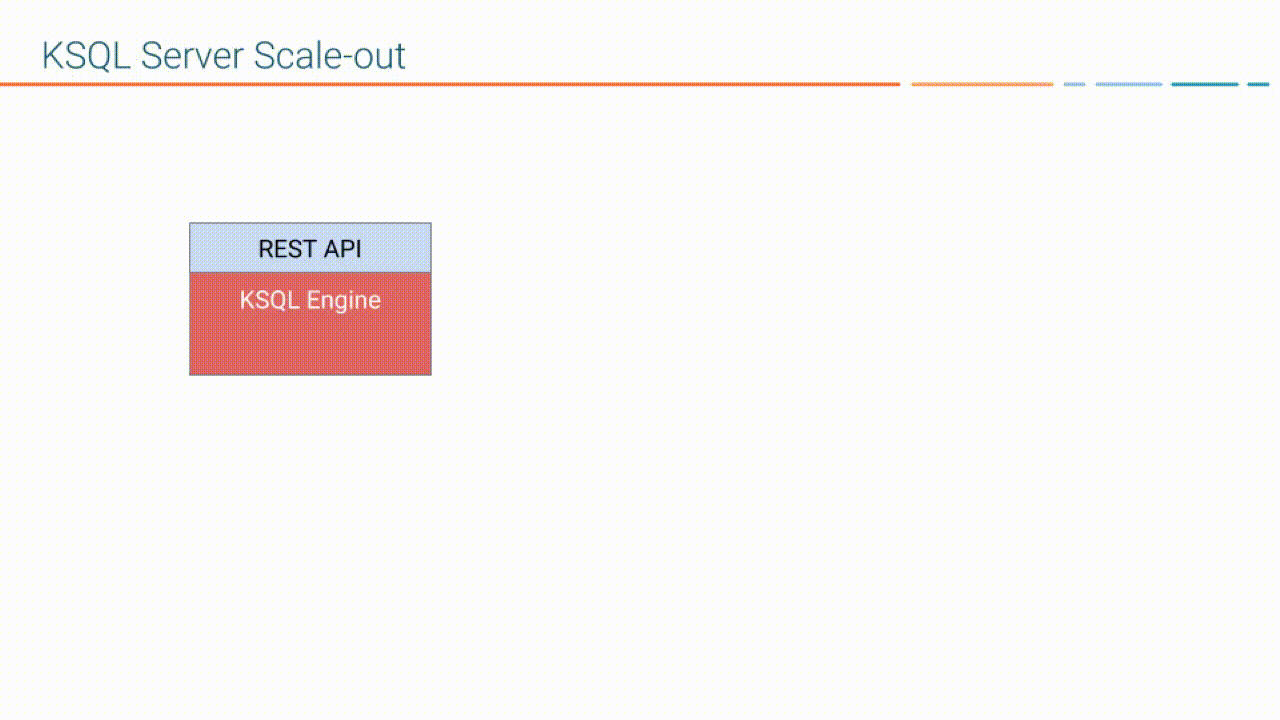
Diagram showing architecture of ksqlDB
ksqlDB and Kafka Streams
ksqlDB is built on Kafka Streams, a robust stream processing framework that is part of Apache Kafka®. You can use ksqlDB and Kafka Streams together in your event streaming applications.
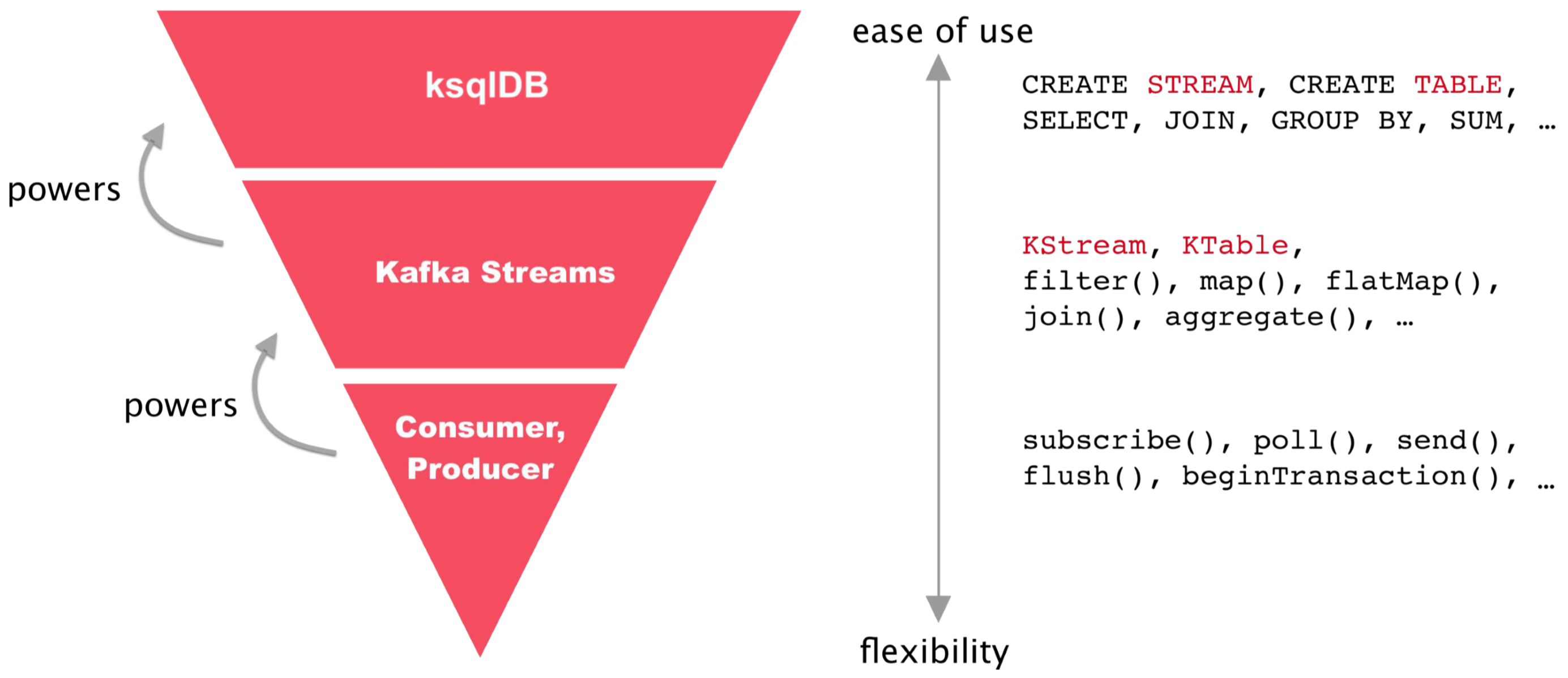
The Confluent Platform stack, with ksqlDB built on Kafka Streams
ksqlDB gives you a query layer for building event streaming applications on Kafka topics. ksqlDB abstracts away much of the complex programming that’s required for real-time operations on streams of data, so that one line of SQL can do the work of a dozen lines of Java or Scala.
For example, to implement simple fraud-detection logic on a Kafka topic named payments, you could write one line of SQL:
CREATE STREAM fraudulent_payments AS
SELECT fraudProbability(data) FROM payments
WHERE fraudProbability(data) > 0.8
EMIT CHANGES;
The equivalent Scala code on Kafka Streams might resemble:
// Example fraud-detection logic using the Kafka Streams API.
object FraudFilteringApplication extends App {
val builder: StreamsBuilder = new StreamsBuilder()
val fraudulentPayments: KStream[String, Payment] = builder
.stream[String, Payment]("payments")
.filter((_ ,payment) => payment.fraudProbability > 0.8)
fraudulentPayments.to("fraudulent-payments-topic")
val config = new java.util.Properties
config.put(StreamsConfig.APPLICATION_ID_CONFIG, "fraud-filtering-app")
config.put(StreamsConfig.BOOTSTRAP_SERVERS_CONFIG, "kafka-broker1:9092")
val streams: KafkaStreams = new KafkaStreams(builder.build(), config)
streams.start()
}
ksqlDB is easier to use, and Kafka Streams is more flexible. Which technology you choose for your real-time streaming applications depends on a number of considerations. Keep in mind that you can use both ksqlDB and Kafka Streams together in your implementations.
Also, you can implement custom logic and aggregations in your ksqlDB applications by implementing user defined functions (UDFs) in Java.
Differences Between ksqlDB and Kafka Streams
The following table summarizes some of the differences between ksqlDB and Kafka Streams.
Differences | ksqlDB | Kafka Streams |
|---|---|---|
You write: | SQL statements | JVM applications |
Graphical UI | Yes, in Confluent Control Center (Legacy) and Confluent Cloud | No |
Console | Yes | No |
Data formats | Avro, Protobuf, JSON, JSON_SR, CSV | Any data format, including Avro, JSON, CSV, Protobuf, XML |
REST API included | Yes | No, but you can implement your own |
Runtime included | Yes, the ksqlDB server | Applications run as standard JVM processes |
ksqlDB Language Elements
Like traditional relational databases, ksqlDB supports two categories of statements: Data Definition Language (DDL) and Data Manipulation Language (DML).
These categories are similar in syntax, data types, and expressions, but they have different functions in ksqlDB Server.
Data Definition Language (DDL) Statements
Imperative verbs that define metadata on the ksqlDB Server by adding, changing, or deleting streams and tables. Data Definition Language statements modify metadata only and don’t operate on data. You can use these statements with declarative DML statements.
The DDL statements include:
CREATE STREAM
CREATE TABLE
DROP STREAM
DROP TABLE
CREATE STREAM AS SELECT (CSAS)
CREATE TABLE AS SELECT (CTAS)
Data Manipulation Language (DML) Statements
Declarative verbs that read and modify data in ksqlDB streams and tables. Data Manipulation Language statements modify data only and don’t change metadata. The ksqlDB engine compiles DML statements into Kafka Streams applications, which run on a Kafka cluster like any other Kafka Streams application.
The DML statements include:
SELECT
INSERT INTO
INSERT INTO VALUES
CREATE STREAM AS SELECT (CSAS)
CREATE TABLE AS SELECT (CTAS)
The CSAS and CTAS statements occupy both categories, because they perform both a metadata change, like adding a stream, and they manipulate data, by creating a derivative of existing records.
ksqlDB Deployment Modes
You can deploy your ksqlDB streaming applications using either Interactive or Headless mode. We recommend using interactive mode when possible.
In both deployment modes, ksqlDB enables distributing the processing load for your ksqlDB applications across all ksqlDB Server instances, and you can add more ksqlDB Server instances without restarting your applications.
Note
All servers that run in a ksqlDB cluster must use the same deployment mode.
Interactive Deployment
When you deploy a ksqlDB server in interactive mode, the REST interface is available for the ksqlDB CLI and Confluent Control Center (Legacy) to connect to. This allows you to add and remove persistent queries without restarting the servers.
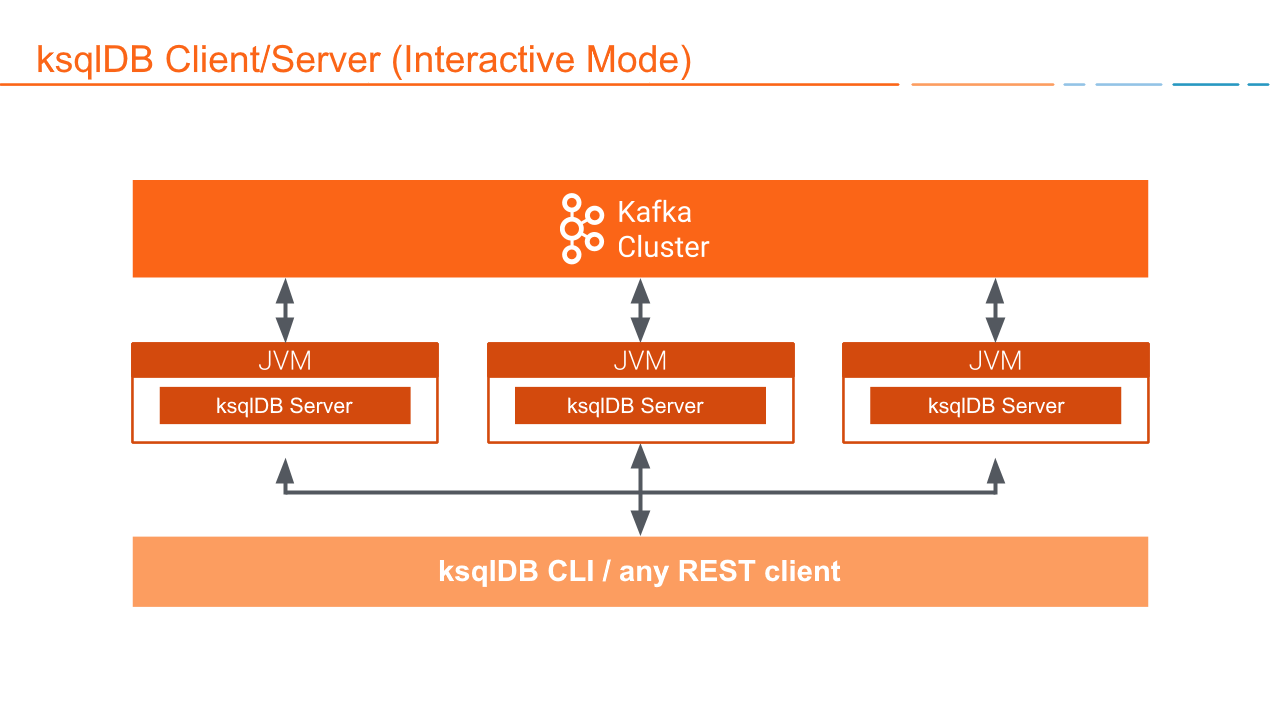
Diagram showing interactive ksqlDB deployment
In interactive mode, you can:
Write statements and queries on the fly
Start any number of server nodes dynamically:
<path-to-confluent>/bin/ksql-server-startStart one or more CLIs or REST Clients and point them to a server:
<path-to-confluent>/bin/ksql https://<ksql-server-ip-address>:8090
Command Topic
In interactive mode, ksqlDB shares statements with servers in the cluster over the command topic. The command topic stores every SQL statement, along with some metadata that ensures the statements are built compatibly across ksqlDB restarts and upgrades. ksqlDB names the command topic _confluent-ksql-<service id>command_topic, where <service id> is the value in the ksql.service.id property.
By convention, the ksql.service.id property should end with a separator character of some form, for example a dash or underscore, as this makes the topic name easier to read.
Note
In Confluent Cloud, the Command Topic is managed by Confluent and not visible in the Kafka cluster. Previous versions of ksqlDB in Confluent Cloud created a Command Topic in user-owned Kafka clusters, but this isn’t the case for newly created ksqlDB clusters.
Headless Deployment
When you deploy a ksqlDB Server in headless mode, the REST interface isn’t available, so you assign workloads to ksqlDB clusters by using a SQL file. This can be useful if you want to completely lock down the set of persistent queries that ksqlDB will run. The SQL file contains the SQL statements and queries that define your application.
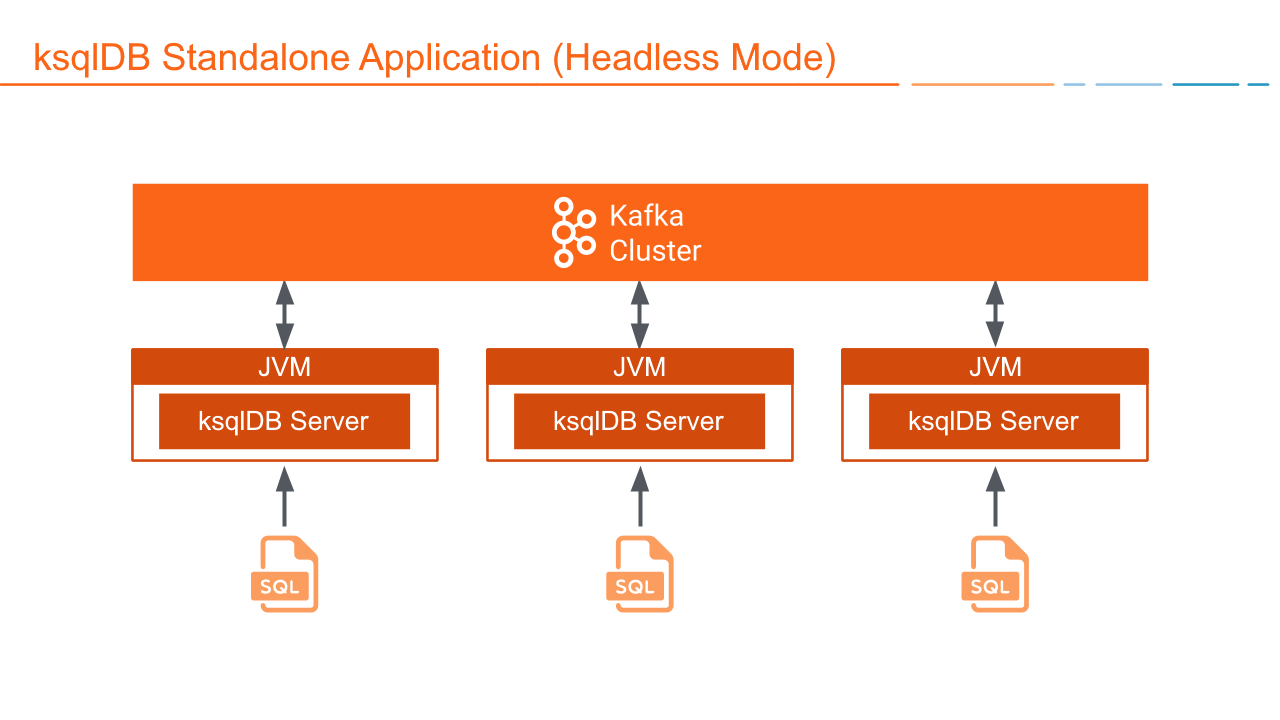
Diagram showing headless ksqlDB deployment
In headless mode you can:
Start any number of server nodes
Pass a SQL file with SQL statements to execute:
<path-to-confluent>bin/ksql-node query-file=path/to/myquery.sqlEnsure resource isolation
Leave resource management to dedicated systems, like Kubernetes
Note
Headless mode deployments don’t have a command topic.
Config Topic
In headless mode, you supply SQL statements to each server in its SQL file. But ksqlDB still needs to store some internal metadata to ensure that it builds queries compatibly across restarts and upgrades. ksqlDB stores this metadata in an internal topic called the config topic. ksqlDB names the config topic _confluent-ksql-<service id>_configs, where <service id> is the value in the ksql.service.id property.
Supported Operations in Headless and Interactive Modes
The following table shows which SQL operations are supported in headless and interactive deployments.
SQL Operation | Interactive ksqlDB | Headless ksqlDB |
|---|---|---|
Describe a stream or table, including runtime stats (DESCRIBE, DESCRIBE EXTENDED) | Supported | Not Supported |
Explain a query, including runtime stats (EXPLAIN) | Supported | Not Supported |
CREATE a stream or table | Supported | Supported |
DROP a stream or table | Supported | Not Supported |
List existing streams and tables (SHOW STREAMS, SHOW TABLES) | Supported | Not Supported |
List running queries (SHOW QUERIES) | Supported | Not Supported |
Describe existing streams and tables (DESCRIBE STREAMS, DESCRIBE TABLES) | Supported | Not Supported |
Operations on connectors (CREATE CONNECTOR, DROP CONNECTOR, SHOW CONNECTORS) | Supported | Not Supported |
Run a script (RUN SCRIPT) | Supported | Not Supported |
Set query properties (SET) | Supported | Supported |
Show contents of a Kafka topic (PRINT) | Supported | Not Supported |
Show contents of a stream or table (SELECT) | Supported | Not Supported |
Show properties of a query (SHOW PROPERTIES) | Supported | Not Supported |
Show results of a query (SELECT) | Supported | Not Supported |
PAUSE / RESUME a persistent query | Supported | Not Supported |
TERMINATE a query | Supported | Not Supported |
Start and stop a ksqlDB Server instance | Not with ksqlDB API | Not with ksqlDB API |
Cleanup and delete internal data (internal topics) of a ksqlDB cluster or application | Supported (ksqlDB REST API) | Not with ksqlDB API |
Note
You can perform operations listed as “Not with ksqlDB API” manually. Also, you can use deployment tools, like Kubernetes or Ansible, and you can use the Kafka tools, like kafka-delete-records.
Dedicating Resources
Join ksqlDB engines to the same service pool by using the ksql.service.id property. The following diagram shows a Kafka cluster with separate workloads for a finance pool and a sales pool. For more information, see ksql.service.id.
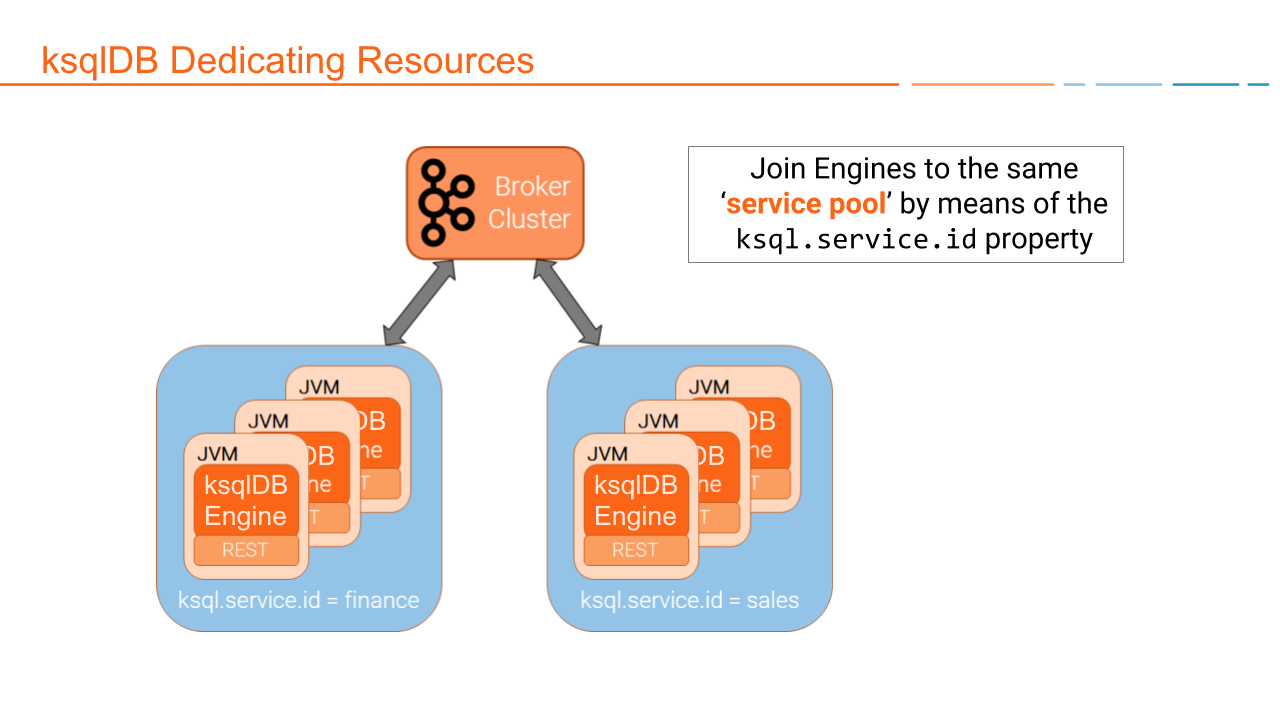
Diagram showing how to join ksqlDB engines to the same service pool
To scale out, just add more ksqlDB server instances. There’s no master node or coordination among them required. For more information, see Capacity Planning.
ksqlDB Query Lifecycle
To create a streaming application with ksqlDB, you write SQL statements and queries. Each statement and query has a lifecycle with the following steps:
You register a ksqlDB stream or table from an existing Kafka topic with a DDL statement, like
CREATE STREAM <my-stream> WITH <topic-name>.You express your app by using a SQL statement, like
CREATE TABLE AS SELECT FROM <my-stream>.ksqlDB parses your statement into an abstract syntax tree (AST).
ksqlDB uses the AST and creates the logical plan for your statement.
ksqlDB uses the logical plan and creates the physical plan for your statement.
ksqlDB generates and runs the Kafka Streams application.
You manage the application as a STREAM or TABLE with its corresponding persistent query.
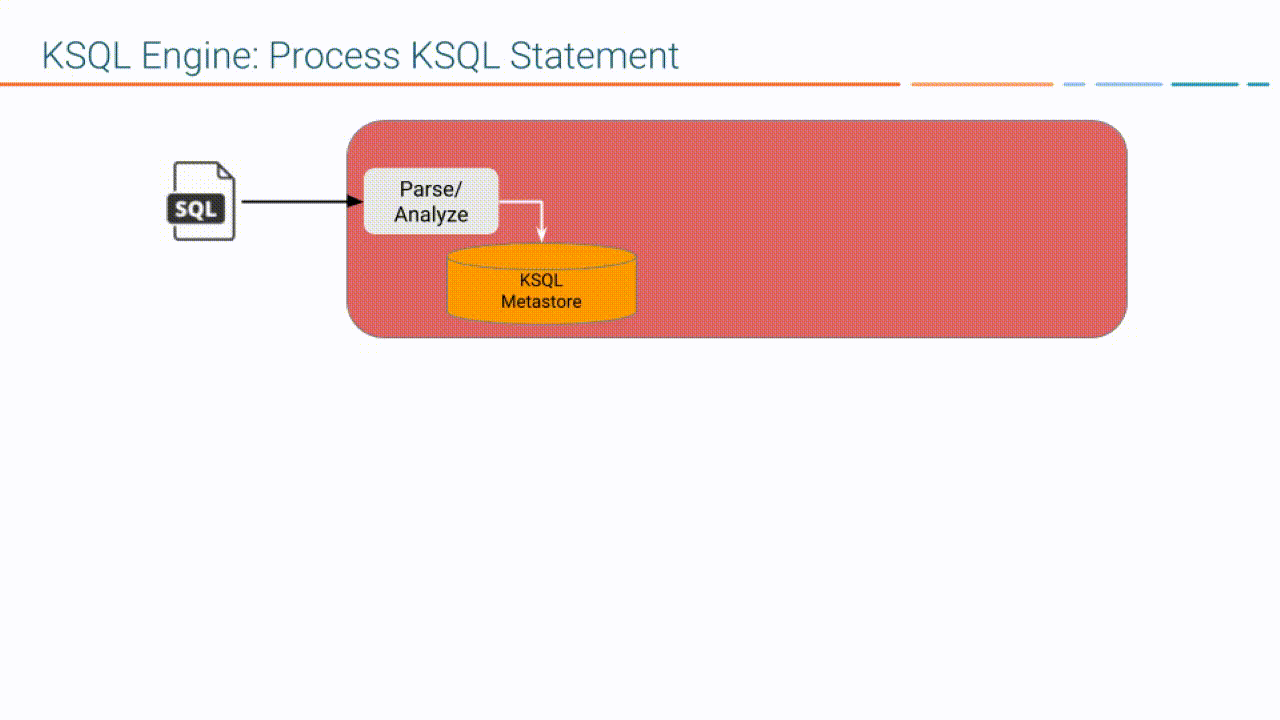
Diagram showing how the ksqlDB query lifecycle for a SQL statement
Register the stream
Register a stream or table by using the DDL statements, CREATE STREAM and CREATE TABLE. For example, the following SQL statement creates a stream named authorization_attempts that’s backed by a topic named authorizations.
CREATE STREAM authorization_attempts
(card_number VARCHAR, attemptTime BIGINT, ...)
WITH (kafka_topic='authorizations', value_format=‘JSON');
ksqlDB writes DDL and DML statements to the command topic. Each ksqlDB Server reads the statement from the command topic, parsing and analyzing it.

Diagram showing deployment of a SQL file to a command topic
The CREATE STREAM statement is a DDL statement, so the action is to update the ksqlDB metadata.
Each ksqlDB Server has an internal, in-memory metadata store, or metastore, that it builds as it receives DDL statements. The metastore is an in-memory map. For each new DDL statement, the ksqlDB engine adds an entry to the metastore.
For example, the metastore entry for the previous CREATE STREAM statement might resemble:
Source Name | Structured Data Source |
|---|---|
AUTHORIZATION_ATTEMPTSMPTS | [DataSourceType: STREAM], [Schema:(card_number VARCHAR, attemptTime BIGINT, attemptRegion VARCHAR, …)], [Key: null], [KsqlTopic: AUTHORIZATIONS], … |
The ksqlDB metastore is implemented in the io.confluent.ksql.metastore package.
Express Your Application as a SQL Statement
Now that you have a stream, express your application’s business logic by using a SQL statement. The following DML statement creates a possible_fraud table from the authorization_attempts stream:
CREATE TABLE possible_fraud AS
SELECT card_number, count(*)
FROM authorization_attempts
WINDOW TUMBLING (SIZE 5 SECONDS)
WHERE region = ‘west'
GROUP BY card_number
HAVING count(*) > 3
EMIT CHANGES;
The ksqlDB engine translates the DML statement into a Kafka Streams application. The application reads the source topic continuously, and whenever the count(*) > 3 condition is met, it writes records to the possible_fraud table.
ksqlDB Parses Your Statement
To express your DML statement as a Kafka Streams application, the ksqlDB engine starts by parsing the statement. The parser creates an abstract syntax tree (AST). The ksqlDB engine uses the AST to plan the query.
The SQL statement parser is based on ANTLR and is implemented in the io.confluent.ksql.parser package.
ksqlDB Creates the Logical Plan
The ksqlDB engine creates the logical plan for the query by using the AST. For the previous possible_fraud statement, the logical plan has the following steps:
Define the source – FROM node
Apply the filter – WHERE clause
Apply aggregation – GROUP BY
Project – WINDOW
Apply post-aggregation filter – HAVING, applied to the result of GROUP BY
Project – for the result
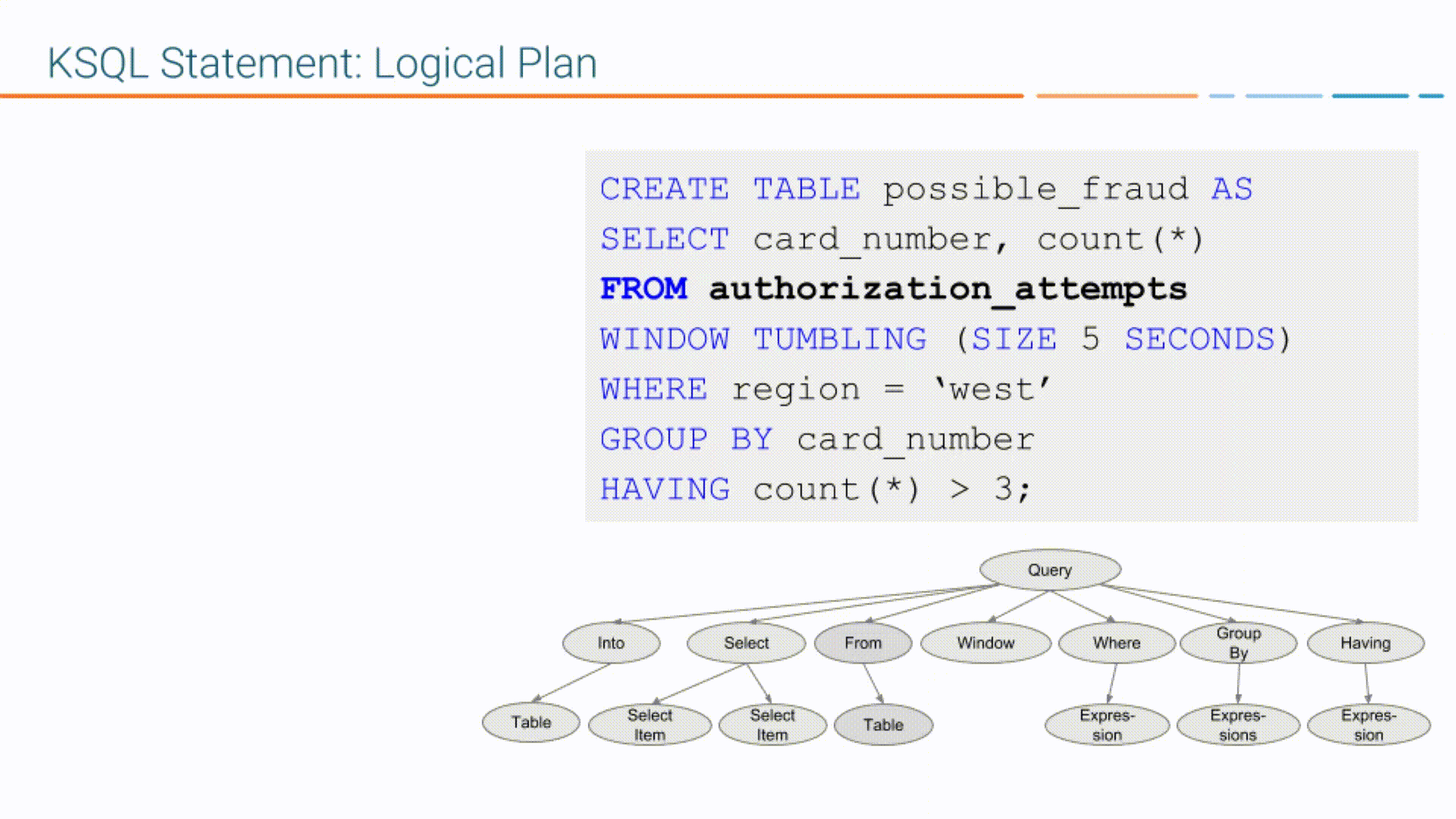
Diagram showing how the ksqlDB engine creates a logical plan for a SQL statement
ksqlDB Creates the Physical Plan
From the logical plan, the ksqlDB engine creates the physical plan, which is a Kafka Streams DSL application with a schema.
The generated code is based on the ksqlDB classes, SchemaKStream and SchemaKTable:
A ksqlDB stream is rendered as a SchemaKStream instance, which is a KStream with a Schema.
A ksqlDB table is rendered as a SchemaKTable instance, which is a KTable with a Schema.
Schema awareness is provided by the SchemaRegistryClient class.
The ksqlDB engine traverses the nodes of the logical plan and emits corresponding Kafka Streams API calls:
Define the source – a
SchemaKStreamorSchemaKTablewith info from the ksqlDB metastoreFilter – produces another
SchemaKStreamProject –
select()methodApply aggregation – Multiple steps:
rekey(),groupby(), andaggregate()methods. ksqlDB may re-partition data if it’s not keyed with a GROUP BY phrase.Filter –
filter()methodProject –
select()method for the result

Diagram showing how the ksqlDB engine creates a physical plan for a SQL statement
If the DML statement is CREATE STREAM AS SELECT or CREATE TABLE AS SELECT, the result from the generated Kafka Streams application is a persistent query that writes continuously to its output topic until the query is terminated.
Developer Workflows
There are different workflows for ksqlDB and Kafka Streams when you develop streaming applications.
ksqlDB: You write SQL queries interactively and view the results in real-time, either in the ksqlDB CLI or in Confluent Control Center (Legacy).
Kafka Streams: You write code in Java or Scala, recompile, and run and test the application in an IDE, like IntelliJ. You deploy the application to production as a jar file that runs in a Kafka cluster.
ksqlDB and Kafka Streams: Where to Start?
Use the following table to help you decide between ksqlDB and Kafka Streams as a starting point for your real-time streaming application development.
Start with ksqlDB when… | Start with Kafka Streams when… |
|---|---|
New to streaming and Kafka | Prefer writing and deploying JVM applications like Java and Scala; for example, due to people skills, tech environment |
To quicken and broaden the adoption and value of Kafka in your organization | Use case is not naturally expressible through SQL, for example, finite state machines |
Prefer an interactive experience with UI and CLI | Building microservices |
Prefer SQL to writing code in Java or Scala | Must integrate with external services, or use 3rd-party libraries (but ksqlDB user defined functions(UDFs) may help) |
Use cases include enriching data; joining data sources; filtering, transforming, and masking data; identifying anomalous events | To customize or fine-tune a use case, for example, with the Kafka Streams Processor API: custom join variants, or probabilistic counting at very large scale with Count-Min Sketch |
Use case is naturally expressible by using SQL, with optional help from UDFs | Need queryable state, which ksqlDB doesn’t support |
Want the power of Kafka Streams but you aren’t on the JVM: use the ksqlDB REST API from Python, Go, C#, JavaScript, shell |
Usually, ksqlDB isn’t a good fit for BI reports, ad-hoc querying, or queries with random access patterns, because it’s a continuous query system on data streams.
Next steps
See ksqlDB in action with the ksqlDB Quick Start.
Learn more with the ksqlDB Tutorials and Examples.
Take the developer courses: Introduction to ksqlDB and ksqlDB Architecture.